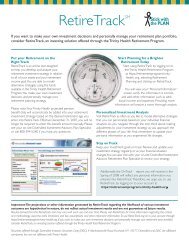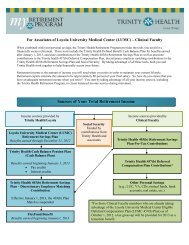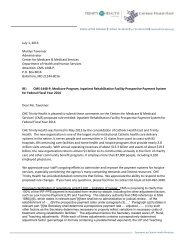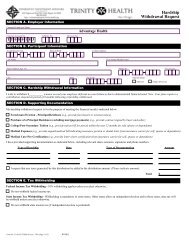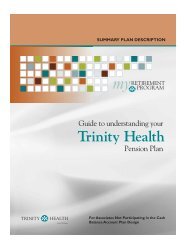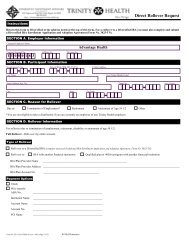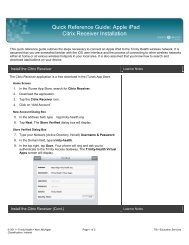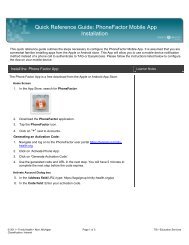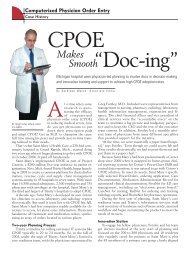supply chain - Trinity Health
supply chain - Trinity Health
supply chain - Trinity Health
You also want an ePaper? Increase the reach of your titles
YUMPU automatically turns print PDFs into web optimized ePapers that Google loves.
S e c t i o n 5<br />
32 LEADERSHIP | Fall/Winter 2009
Integrating the<br />
<strong>supply</strong> <strong>chain</strong><br />
across a<br />
health system<br />
As providers look for ways to improve efficiency and<br />
reduce costs, many are looking at how supplies are<br />
purchased, delivered, and stored.<br />
The average hospital has 40,000 to 50,000<br />
supplies—from bandages to cardiac stents—<br />
listed on its item master, or inventory list. Multiply<br />
that by multiple hospitals in a health system, and<br />
<strong>supply</strong> management quickly adds up to a mammoth and<br />
costly logistical exercise.<br />
Like many U.S. health systems, <strong>Trinity</strong> <strong>Health</strong> has<br />
recognized the potential savings and efficiencies to be<br />
gained with a more centralized approach to <strong>supply</strong> <strong>chain</strong><br />
management. By reducing <strong>supply</strong>-related expenses, the<br />
health system will have more dollars available for IT<br />
upgrades, clinical improvements, and other investments<br />
necessary to achieve its vision of becoming a “care<br />
delivery organization” that delivers the full spectrum of<br />
care in a coordinated, efficient manner.<br />
Efficiencies of Scale<br />
In 2000, when <strong>Trinity</strong> <strong>Health</strong> was created with the<br />
merger of Holy Cross <strong>Health</strong> System and Mercy <strong>Health</strong><br />
Services, the opportunities for creating efficiencies were<br />
vast. One of the objectives: centralize <strong>supply</strong> <strong>chain</strong><br />
operations across the Novi, Mich., system’s 44 acute<br />
care hospitals and dozens of ancillary facilities that are<br />
spread across seven states.<br />
Lou Fierens, hired as senior vice president of <strong>supply</strong><br />
<strong>chain</strong> and capital project management, was given five<br />
years to reduce <strong>supply</strong> <strong>chain</strong> costs by $110 million.<br />
Fierens and his staff not only reached that goal a year<br />
early, but also brought total cost savings to more than<br />
$350 million over the next few years.<br />
How? While investing in a central <strong>supply</strong> <strong>chain</strong><br />
information system was unavoidable, Fierens says the<br />
initiative was really about putting the right people in the<br />
right positions—and performing the right processes that<br />
brought results.<br />
Strategic Sourcing<br />
One of Fierens’ first initiatives was creating the concept<br />
of strategic sourcing, a procurement process that<br />
involves continuous evaluation of purchasing strategies<br />
to improve efficiencies and reduce costs. First, he hired<br />
category sourcing managers for each clinical and<br />
support service line, such as cardiovascular, orthopedics,<br />
and medical-surgical. These managers are responsible<br />
for identifying ways in which <strong>supply</strong> costs can be<br />
managed more effectively in each service line, using<br />
tactics such as assessing the use of supplies and negotiating<br />
better pricing on contracts.<br />
hfma.org/leadership | LEADERSHIP 33
Fierens then developed the <strong>Trinity</strong> <strong>Health</strong> Strategic<br />
Sourcing Process, which incorporates:<br />
NN<br />
Stakeholder involvement, or involving the end user<br />
in the sourcing process<br />
NN<br />
Transparency, or ensuring that all suppliers have<br />
equal information about the purchasing opportunity<br />
and all stakeholders have information necessary to<br />
evaluate the value of proposals<br />
NN<br />
Competition, or giving suppliers the opportunity<br />
to suggest how <strong>Trinity</strong> <strong>Health</strong> can improve quality<br />
and/or lower costs in creative ways<br />
Separate but Together<br />
Fierens says one of the greatest challenges of the initiative<br />
was changing the culture of separate organizations in<br />
which hospital employees were accustomed to working<br />
independently. To transform that mindset, Fierens<br />
formed a system-level sourcing operations steering team,<br />
which comprises a COO, CFO, or other senior leader<br />
from each hospital in the system. He told team members,<br />
“You are going to help us with establishing our priorities,<br />
you’re going to give us input around how things are<br />
working, helping to guide the work to greatest effect—<br />
with the understanding going in that we’re going to<br />
work together.”<br />
In addition, all hospital-based <strong>supply</strong> <strong>chain</strong> managers<br />
meet annually to agree upon a set of common performance<br />
objectives that each manager will be measured<br />
against. “We are all beginning to speak the same<br />
language around our operating priorities because we’ve<br />
all agreed on what these priorities are and how they’re<br />
going to be measured,” he says.<br />
Another important step was centralization of<br />
procurement staff. As the <strong>supply</strong> <strong>chain</strong> information<br />
system was installed across the health system, staff<br />
who were previously located in each hospital were<br />
consolidated in one location to serve the entire health<br />
system. “One of the key tenants in taking advantage of<br />
our economies of scale is to create standardized work<br />
processes and have a focused work group perform the<br />
activity. In this way, we can elevate a ‘back office<br />
function’ to a strategic source of information and<br />
common practice,” says Fierens.<br />
“Our next phase is consolidation of accounts payable.<br />
Our vision is to streamline the procure-to-pay process<br />
to better manage the entire ‘req to check’ process giving<br />
us the ability to better manage cash,” he says.<br />
Partnering with Physicians<br />
At <strong>Trinity</strong> <strong>Health</strong>, most of the physicians are independent,<br />
which makes gaining their support in reducing<br />
<strong>supply</strong> costs more difficult, says Fierens. “Those<br />
relationships take a long time to build. We are in a<br />
better place today, but we could have moved further<br />
faster had we engaged physicians more directly.”<br />
Developing formularies for supplies, for example, would<br />
have helped in controlling hospital spend much earlier<br />
because physicians would have had a protocol to follow<br />
for using certain medications for specific cases.<br />
“We really need to partner in the care delivery<br />
process with physicians and other clinicians so we can<br />
make the best decisions around our <strong>supply</strong> catalog, or<br />
our formulary for supplies,” says Fierens. “Physicians<br />
and clinicians are interested in data, and data can drive<br />
behavior. Creating transparency to the greatest extent<br />
possible around the impact on outcomes—and cost is<br />
an outcome—is important.”<br />
Supplying the Margin<br />
<strong>Trinity</strong> <strong>Health</strong> has been able to measure average annual<br />
savings of about $50 million, for an ROI of 15:1. Plus,<br />
the health system has seen improved operating margins.<br />
When Fierens joined <strong>Trinity</strong> <strong>Health</strong> in 2001, the margin<br />
was 0.09 percent, he says. In FY07 and FY08, the<br />
margin exceeded 5 percent. Even with the recession,<br />
the margin topped 3 percent last fiscal year.<br />
Revenue improvement and other operational<br />
initiatives contributed to <strong>Trinity</strong>’s success. “But there<br />
isn’t any way that result would have been achieved at<br />
the level it was without the <strong>supply</strong> <strong>chain</strong> contribution,”<br />
he says. “Supply <strong>chain</strong> management is the key pillar in<br />
managing nonlabor expense.” n<br />
Learn more about <strong>Trinity</strong> <strong>Health</strong>’s <strong>supply</strong> <strong>chain</strong> initiative<br />
in the upcoming December 2009 issue of HFMA’s <strong>Health</strong>care Cost Containment. Each issue of this subscriber-based<br />
newsletter gives you provider-tested tactics for carving millions off your expenses while supporting high quality.<br />
➔<br />
Learn more at www.hfma.org/HCC.<br />
34 LEADERSHIP | Fall/Winter 2009<br />
Republished with permission from the Fall/Winter 2009 Leadership Special Report, copyright 2009, HFMA Learning Solutions, Inc., www.hfma.org/leadership





